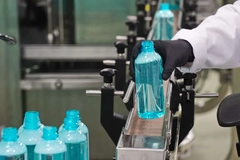Scant promise for raw poultry by pulsed electric fields
25 Oct 2011

Pulsed electric fields (PEF) may not be suitable for controlling Campylobacter levels in raw chicken, but could potentially be used to control levels in scald or chilled processing water.
Pulsed electric fields (PEF) may not be suitable for controlling Campylobacter levels in raw chicken, but could potentially be used to control levels in scald or chilled processing water.
That’s the conclusion of a new study from scientists at University College Dublin (UCD), who found that Campylobacter was more susceptible to destruction via PEF treatment in liquid media than Escherichia coli (E.coli) and Salmonella Enterititidis.
Haughton et al. also found previously unreported “significant differences” in susceptibility to PEF between 10 different Campylobacter isolates.
Previously, a team at UCD found that high-intensity pulsed light significantly reduced bacteria counts for the same 3 pathogens on chicken and associated packaging.
Continued research into pathogen control reflects European Food Safety Authority (EFSA) estimates that there are 9m EU cases of Campylobacter infection each year, with a large proportion due to handling, preparation and consumption of chicken meat, as well as contaminated processing water.
‘Lethal’ to spoilage bacteria
Against this backdrop, Haughton et al. noted that PEF – applying short pulses of high-voltage electric fields to food flowing through or placed between 2 electrodes – was a non-thermal decontamination treatment “lethal to many pathogenic and spoilage bacteria”.
The scientists said previous data suggested that PEF technology was better-suited to inactivating microorganisms in liquid or semi-solid foods (Mosqueda-Melgar et al. 2008), but that its effectiveness upon poultry had not been studied.
Haughton et al. added: “The authors are unaware of any studies that may have investigated the potential of PEF for the decontamination of solid foods such as chicken.
“There is growing interest in exploring and identifying technologies that could reduce contamination of chicken carcasses, as risk assessment studies predict that reducing the microbial load on carcasses can result in a significant reduction in the incidence of gastroenteritis in humans.”
And while traditional thermal treatments were effective to a degree, the authors noted that they may have a negative impact on the appearance of broiler skin.
Processing water application
Haughton et al. found that PEF was an effective intervention measure in liquid media, with all Campylobacter isolates tested in liquid registering reductions of 4.33-7.22 log CFU/ml (colony-forming units per millilitre) after 30 seconds of treatment.
However, significant differences in susceptibility were observed across Campylobacter isolates, with those processed in liquid media showing reductions of 2.41-5.19 log CFU/ml.
Meanwhile, E.coli and S.Enteritidis in liquid were both found to be less sensitive than Campylobacter (P < 0.05), while the application of PET to raw chicken samples did not result in any significant reductions in total viable counts.
The team said this finding highlighted the importance of strain selection in PET inactivation studies involving Campylobacter spp.
Haughton et al. wrote: “Although the results of this study indicate the unsuitability of PEF for decontaminating raw chicken, it may have a potential application in controlling levels of Campylobacter in scald or chill water used during the processing of chicken.”
Source: Food Control
All content and features on this website are copyrighted with all rights reserved. The full details can be found in our privacy statement
Subscribe to our newsletters
By continuing to browse our site you agree to our Privacy Statement











